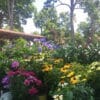by Val Khislavsky
What you think of as an Amaryllis may not be one after all.

L: The real Amaryllis belladonna; R: what most of us think of as an “Amaryllis”
Photos: L: Wikipedia Commons: Stan Sheb; R: Tulipworld.com.
First, a little history: in an excerpt from her book Amaryllis, Starr Ockenga tells us that Amaryllis aren’t really Amaryllis at all. Instead, they’re Hippeastrum, the “correct genus name for cultivated amaryllis hybrids.” Look up “Amaryllis” on wikipedia, and you are presented with Amaryllis belladonna, a native South African bulb that looks more like a lily that what we think of as an Amaryllis. Ockenga writes that A. belladonna is a true Amaryllis while the now widely-cultivated bulbs that we think to be Amaryllis are actually Hippeastrum, which originated from the Andes of South America. However, both true Amaryllis and Hippeastrum are associated with the common name Amaryllis, which, admittedly, is the easier of the two to remember and pronounce. In case that’s not confusing enough, there’s also the Hippeastrum cybister, which is a separate hybrid species of Hippeastrum. All that said, here are a few fun Amaryllis Hippeastrum picks to brighten up your indoors.

L: Julie’s Hippeastrum cybister ‘rosado’ in bloom; R: “Amaryllis Cybister.” Photos: L: Julie Messervy; R: White Flower Farm.
Although many of us opt for traditional bloomers in our homes and offices, we all can’t help but daydream about a few of the quirkier ones out there. Take for example the Hippeastrum cybister ‘rosado’ with its striking pointed petals–there’s something to be said for a bulb that can compete with a purple wall! Or for a subtler version try the chartreuse cybister option. Both have smaller petals than the traditional amaryllis but pack an unexpected punch of color and form.

L: “Amaryllis Amputo”; R: “Amaryllis Aphrodite.” Photos: L: Easy to Grow Bulbs; R: White Flower Farm.
If you’re not ready to take the plunge with cybister, there are some more traditional-looking but still unique bulbs to choose from. The clean aesthetic of the “Amaryllis Amputo’s” trumpet-shaped blooms and the romantic double-blooming petals of the “Amaryllis Aphrodite” are sure to please. Something to think about with Valentine’s day fast approaching–you know a plant lover can never have too many!
I myself have have been lusting after the “Amaryllis Papilio,” with its variegated petals and rich, contrasting colors. It is so named because its petals resemble butterfly wings. I also couldn’t resist the bright orange “Amaryllis Naranja.” While not my favorite color, it’s undeniably eye-catching.

L: “Amaryllis Papilio”; R: “Amaryllis Naranja.” Photos: L: Jackson & Perkins; R: White Flower Farm.
Thankfully, it’s easier to care for Hippeastrum than to trace its origins. White Flower Farm provides a useful guide to their care, from planting, to growing, to storing for the next season. With the attention, Hippeastrum will gladly come back and bloom year after year.






For more on Hippeastrum history and care, check out Gardener’s World presenter Alys Fowler’s “Indoor Fireworks” article in the December 2009 issue of Gardens Illustrated (roll over for link).
Click here for more on Alys.
Are Hippeastrum easily found in florists or would i have to send away for the bulbs?
Hi Frederick,
Hippeastrum are generally available at your local garden shop, but will likely be marketed under the name “Amaryllis.” Calling ahead is always a good idea at this point in the season. Let us know what you find!
Thanks Val, i’ll let you know. By the way, are you guys going to come to Long Island any time soon ?
Hi Frederick,
No Long Island plans as of yet, but anything is possible!